Norwegian Emerald Parure - Empress Josephine's Emerald Parure
Open FREE Unlimited Store Join Our Newsletter
Origin of name
The Norwegian Parure, which is part of the Norwegian Crown Jewels, set with lovely dark and rich green emeralds that probably originated in the Muzo or Somondoco emerald mines in Colombia, has a rich history and provenance associated with it. The Parure was said to have been originally owned by Empress Josephine, the Empress Consort and first wife of Napoleon Bonaparte, who was well known for having lavished extravagant jewelry that also included valuable parures on his first Empress Consort Josephine and subsequently on his second Empress Consort Marie-Louise. After Napoleon divorced Empress Josephine in January 1810, as she was not able to give him a son and successor, she retained all the jewelry that was gifted to her by Napoleon during her tenure as the Empress Consort of France. Napoleon also continued to maintain her while she lived in her private residence outside Paris.
Empress Josephine had two children by her previous marriage to Alexandre vicomte de Beauharnais, a daughter Hortense de Beauharnais who married Louis Bonaparte, a younger brother of Napoleon, and a son Eugene de Beauharnais who married Princess Augusta Amelia, daughter of Maximilian I, the King of Bavaria. Empress Josephine bequeathed part of her jewelry to her son and the other part to her daughter at the time of her death. She bequeathed her emerald parure to her son Eugene de Beauharnais, who gave it to his wife Princess Augusta Amelia. Eugene de Beauharnais and Princess Amelia had two daughters, Amelia and Josephine. Princess Augusta Amelia gifted the celebrated emerald parure to her daughter Amelia of Leuchentenberg, at the time of her marriage to Emperor Pedro I of Brazil. When Amelia died in 1873, she bequeathed all her jewelry including the emerald parure to her sister, Josephine of Leuchentenberg, the Queen Consort of Oscar I of Norway and Sweden. Since then the emerald parure had remained in the Norwegian royal family, and thus came to be known as the Norwegian Emerald parure.
Components of the Norwegian Emerald Parure
The term "parure" derived from French, meaning "adornment" was used in the 17th century to refer to a set of three or more matching pieces of jewelry. Sometimes the word "demi-parure" was used to refer to just two pieces of matching jewelry. It appears that originally the Norwegian Emerald Parure consisted of three main pieces of jewelry, a tiara, a necklace, and a brooch, but was later modified by removing two matching emeralds from the necklace, that were transformed to a pair of matching earrings. Thus, the Norwegian Emerald Parure as it is today, consists of the following four components :-
1) The Emerald and Diamond Tiara
2) The Emerald and Diamond Necklace
3) A Pair of Emerald and Diamond Earrings
4) An Emerald and Diamond Brooch
1) The Norwegian Emerald and Diamond Tiara - Empress Josephine Emerald and Diamond Tiara
The Norwegian Emerald and Diamond Tiara, whose provenance has been traced back to the Napoleonic era, appears to be based on the neo-classical design prevalent during that period. The neo-classical era in jewelry crafting extends from the late 1700's (around 1760) to the early 1800's (around 1830), and are characterized by typical shapes and ornamentation, that are highly inspired by the classical themes of ancient Greece and ancient Rome. There was a high level of symmetry in these designs, and the popular motifs of this period included rosettes, festoons, half fluted pillars, vases, urns, ribbon bows, hearts, portraits and snakes. Later other motives were added, such as palmettes, sphinxes, meanders, wine and acanthus leaves, as well as the crescent moon and the star. The shapes used during this period were geometric shapes, such as squares, rectangles, polygons, rhomboids, ovals, navettes (marquises), and shields.
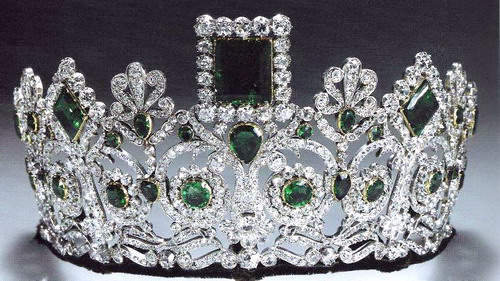
The Norwegian Emerald and Diamond Tiara is based on a highly symmetrical design, consisting of a square, rhomboids and palmettes on the upper side of the tiara, rosettes in the middle, and S-shaped motifs on the lower side of the tiara. The tiara is symmetrical with respect to its median line, along which is placed a large square-shaped cabochon-cut emerald, surrounded by a layer of round brilliant-cut emeralds, at the top of the tiara, and as its centerpiece. Just below the large square-shaped emerald is a smaller pear-shaped cabochon-cut emerald, also placed along the median line. On either side of the large square-shaped emerald, a palmette, a rhomboid, another palmette and an oval-shaped emerald, are placed alternately and symmetrically, on the upper-side of the tiara, arising from a zig-zag band encrusted with round brilliant-cut diamonds. The five-rays of the palmette, arise from an oval-shaped cabochon emerald. The rhomboid (actually a square with one diagonal aligned with the vertical) is occupied by a large cabochon-cut emerald in the center, surrounded by layer of round brilliant-cut diamonds. The oval-shaped emeralds at the extreme ends of the tiara, are also surrounded by a single layer of round brilliant-cut emeralds.
The middle part of the tiara is occupied by rosettes, placed symmetrically on either side of the median line. Each rosette is made up of a central large round-shaped cabochon-cut emerald, surrounded by a row of small round brilliant-cut diamonds. Each rosette is surrounded by a scroll also encrusted with diamonds. The scrolls are arranged in pairs, one coiling in the clockwise direction and the other in the anti-clockwise direction. The S-shaped motifs arranged on the lower side of the tiara, are also studded with diamonds.
Overall, the Norwegian Emerald and Diamond Tiara can be considered as a masterpiece of the neo-classical design of tiaras, like the Marie-Louise Emerald and Diamond Diadem, with which it shares many characteristics, such as the square, palmette and rosette motifs. The square and palmette motifs are also found on the Marie-Louise Emerald and Diamond Necklace. Thus, we can say without any doubt, that the Norwegian Emerald and Diamond Tiara also originated during the period of Napoleon Bonaparte, like the Marie-Louise Emerald and Diamond Diadem. In fact it appears that both tiaras must have been designed and crafted by the same jewelers Marie-Etienne & Sons, who were appointed as court jewelers by Napoleon Bonaparte. While the Norwegian Emerald and Diamond Tiara together with the other components of the parure were gifted by Napoleon to Empress Josephine, his first wife, the Marie-Louise Emerald and Diamond Diadem, accompanied by the other components of the parure, were given as a wedding gift to Empress Marie-Louise, his second wife.
2) The Norwegian Emerald and Diamond Necklace - Empress Josephine Emerald and Diamond Necklace
The emerald and diamond necklace consists of equally spaced rosettes, made up of a single large cushion-shaped or oval-shaped emerald, surrounded by small round brilliant-cut diamonds. The centerpiece of this necklace contains a cushion-shaped emerald, from which hangs a single pendant, made up of a round-shaped emerald, surrounded by a single layer of round brilliant-cut diamonds. Two leaf-like motifs encrusted with diamonds arise from the base of the pendant. It is said that during the time of Queen Sofia of Sweden who also inherited the necklace, there were seven pendants arising from the necklace. This would have been somewhat similar to the Marie-Louise Emerald and Diamond Necklace, which was surrounded by ten drop-shaped emeralds.
3) A pair of Emerald and Diamond Earrings
Originally the parure had no earrings, but two matching drop-shaped emeralds dismantled either from the tiara or necklace were used in designing the emerald and diamond earrings. The drop-shaped emerald in each of the earrings is surrounded by a row of small white diamonds
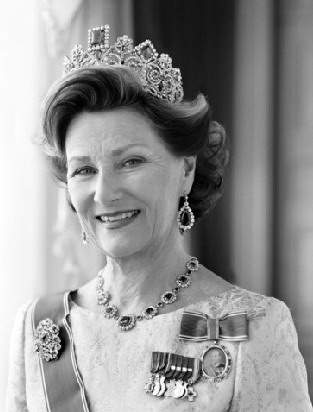
Queen Sonja wearing the emerald and diamond parure
©Royal family of Norway
4) The Emerald and Diamond Brooch
Apart from the fact that the emerald and diamond brooch of the Norwegian parure is a round or circular brooch, no further information is available. A description of the brooch could have been attempted if at least a photograph of the brooch was available. Readers who might have more information on this brooch are requested to provide the same as comments to this page below.
History of the Norwegian Emerald and Diamond Parure
The Parure is given as a gift by Napoleon Bonaparte to his Empress Consort Josephine.
Napoleon Bonaparte the mighty conqueror of lands and nations, was not only a brilliant soldier but also a great patron of the arts. After the devastating effect on the arts, sciences, literature and other peaceful human endeavors, caused by the violent upheavals of the French revolution, a period of relative calm was restored during the rule of Napoleon Bonaparte, that gave a boost to peaceful human activities. Paris, the French capital which had lost its pre-eminence as the fashion center of the world, was on its way trying to regain its lost glory. The jewelry manufacturing sector also got a big boost during this period, and Paris once again emerged as the world center for designing and crafting jewelry. It was reported that in the year 1807, there were 400 jewelers in Paris, employing 800 men and 2,000 women.
One of the most prominent jewelers in Paris during this period, was Marie Etienne Nitot, who had worked previously for the pre-revolution Bourbon monarchs of France, and was appointed by Napoleon Bonaparte as court jewelers. Both Marie Etienne Nitot and his son Francois Regnault were ardent Bonapartists, and Napoleon had a great admiration for their creative abilities. The Norwegian Emerald and Diamond Parure was one of their exquisite creations, commissioned by the Emperor, for his beloved Empress Consort Josephine. But, this was only one of the many items of jewelry that he had lavished on his beloved, during her reign as empress from 1804 to 1810.
Napoleon's close attachment to Empress Josephine ?
During his 14 years of marriage to Josephine, Napoleon was passionately in love with her, save for a brief period of flirtation by Josephine with another army officer, during Napoleon's absence, when he undertook the Egyptian campaign. Napoleon forgave her for her infidelity and the rift was healed up. It appears that Napoleon was actually compelled to divorce Josephine because she could not give him a son, who would be his heir to the throne of France and the future Holy Roman Emperor. Napoleon was exiled to Elba on May 4th, 1814, and Josephine died a few weeks afterwards on May 29, 1814. After Napoleon's escape from Elba and return to mainland France, he ruled for another 100 days, before being finally defeated on June 18, 1815, by the Duke of Wellington, at the Battle of Waterloo. Napoleon was exiled to the island of St. Helena, in the south Atlantic in October 1815. It is said that before he left the shores of France, he expressed a desire to visit the graveyard of his beloved first wife Josephine, which was duly granted. After spending 5½ years in exile in St. Helena, Napoleon died on May 5, 1821. His depth of attachment to Josephine was revealed at the moment of his death on the island of St. Helena, when the great emperor muttered his last words, "France, the Army, the Head of the Army, Josephine." But, his small band of followers and friends in St. Helena, had a greater shock when they opened a locket he was wearing around his neck at the time of his death. The locket contained violets he had picked up from Josephine's gravesite, when he visited the cemetery in 1815.
Thus the Norwegian Emerald and Diamond Parure, that is presently owned by the royal family of Norway, can be considered as a surviving symbol of a mighty emperor's immortal love towards his beloved wife and queen, a love that was nurtured deep within the heart and mind of the lover, but apparently was not manifested openly.
Empress Josephine bequeaths the parure to her son Eugene de Beauharnais, who gave it to his wife Princess Augusta Amelia
Empress Josephine bequeathed the parure to her son Eugene de Beauharnais (1781-1824), the Prince of Venice, Viceroy of Italy and the first Duke of Leuchtenberg. Eugene de Beauharnais gave the parure to his wife, Princess Augusta Amelia (1788-1851), the Duchess of Leuchtenberg, and the daughter of Maximilian I Joseph (1756-1825), the King of Bavaria. Eugene de Beauharnais and Augusta Amelia had seven children. The eldest daughter was Josephine (1807-1876), who became the Queen Consort to Oscar I of Sweden (1799-1859).
Princes Augusta Amelia gives the emerald and diamond parure to her 4th child Princess Amelie
Princes Augusta Amelia gave the emerald and diamond parure to her 4th child, Princess Amelie (1812-1873) of Leuchtenberg, who married Emperor Pedro I of Brazil in 1829.

Emperor Pedro I, abdicated the crown of Brazil on April 7, 1831, and went to Europe with his wife Empress Amelie, and began preparations for the conquest of Portugal, to reclaim his throne from the usurper, his brother Don Miguel, who was declared king by his supporters in 1828. He raised funds for his cause, purchased weapons and organized an expeditionary force, that landed in the Island of Terceria, in the Azores, in February 1832. The island of Terceria served as a springboard, from where attacks were mounted on the mainland. The expeditionary force first landed and occupied the city of Porto, in July 1832. From there they moved to Algarve in June 1833, and captured Lisbon in July 1833. Finally in May 1834, Don Miguel capitulated, at Evora Monte, and was exiled from the country. Having regained his throne in May, 1834, Pedro I, ruled only for four months, and died in September 1834. Pedro I, was succeeded by his daughter, from his first marriage, Maria da Gloria, who ascended the throne of Portugal as Queen Maria II, at the age of 15 years.
Empress Amelie bequeaths the emerald parure to her elder sister Queen Josephine of Sweden and Norway
Following her husband's death, Empress Amelie, the Duchess of Leuchtenberg and Braganza, dedicated herself to a life of helping charities, and also took care of her only child, Princess Maria Amelia, who died from tuberculosis in the Madeira Islands. Empress Amelie was only 22 years, at the time of the death of her husband Pedro I. She remained in Portugal after her husbands death, devoting her life entirely to charitable causes. She outlived her husband by 39 years, and in the year 1873, when she was lying seriously sick, her elder sister Josephine, the Queen Consort of Oscar I of Sweden, her closest surviving relative, traveled to Lisbon, to take care of her dying sister. In her last will, Empress Amelie bequeathed her emerald parure, and most of her other jewelry to her elder sister Josephine.
Queen Josephine bequeaths the emerald parure to her daughter-in-law Queen Sofia of Sweden
King Oscar I and Queen Josephine of Sweden and Norway

Queen Josephine of Sweeden
Josephine of Leuchtenberg, married crown prince Oscar I of Sweden and Norway, in 1823. In 1844, on the death of his father Charles XIV, Oscar I ascended the throne as King, and Princess Josephine became the Queen consort. Josefina was a very popular Queen both within the court and with the public. King Oscar I was responsible for introducing several progressive measures, such as the freedom of the press, and gender equality in inheritance, allowing equal inheritance for brothers and sisters, unless specified otherwise by a will. His cautious foreign policy preserved the territorial integrity of Scandinavia. King Oscar I and Queen Josephine had five children, four sons and a daughter. On his death in 1859, Oscar I was succeeded by his eldest son King Charles XV.
King Charles XV of Sweden and Norway
King Charles XV turned out to be one of the most popular kings of Sweden and Norway in spite of the initial skepticism of his subjects, due to his playboy type of behavior as crown prince, having several mistresses besides his own legal wife. He introduced several far reaching legal reforms, and also the reform of the Riksdag (parliament of Sweden) in 1866, and enacting the law of legal maturity for unmarried women in 1858. A strong advocate of Scandinavianism, Charles XV was also a gifted painter and poet. On his death in September 1872, Charles XV was succeeded by his brother Oscar II, the 3rd son of Oscar I and Queen Josephine.
King Oscar II and Queen Sofia of Sweden and Norway
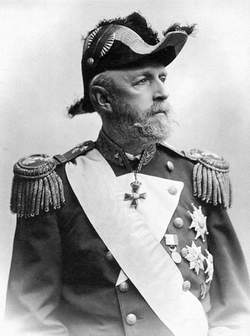
King Oscar II of Sweden and Norway
Oscar II, a graduate in mathematics of the Uppsala University, was an enlightened ruler of the House of Bernadotte, who oversaw the peaceful dissolution of the union between Norway and Sweden. Thus Oscar II was King of Norway and Sweden from 1872 to 1905, and of Sweden alone from 1905 to 1907, the year of his death, the year 1905 being the year the union was dissolved. His enlightened rule that saw the peaceful dissolution of the union, his intelligence, and his experience in resolving crisis situations, taking an independent stand, keeping aloof of dynastic considerations, elevated him to the status of an international statesman, being called upon to resolve many international disputes as an independent arbitrator. He also distinguished himself as a writer, a musical amateur and a enthusiast of Arctic exploration.
Oscar II married Princess Sophia Wilhelmina, the youngest daughter of Duke William of Nassau, on June 6, 1857, and was blessed with four sons, the eldest Gustav V succeeding him as king in 1907. At the time Empress Amelie, bequeathed her emerald parure to her elder sister Queen Josephine in 1873, the King of Sweden and Norway was her third son Oscar II. Ex-Queen Josephine bequeathed the emerald parure to her daughter-in-law Queen Sophia of Nassau, at the time of her death in 1876.
Queen Sofia of Nassau bequeaths the emerald parure to her daughter-in-law Princess Ingeborg, wife of Prince Carl, third son of Queen Sofia and King Oscar II
Queen Sofia had four sons, and the eldest son Gustav V, succeeded her husband Oscar II as King of Sweden in 1907. Gustav V lived up to the ripe old age of 92 years, and served as king for 43 years, steering the country through two World Wars, in both of which Sweden largely adopted a neutral stand. He has gone down in history, as the only world leader who attempted to convince Hitler during a visit to Berlin to soften his persecution of the Jews, and for his appeal to the Hungarian leaders to save its Jews in the name of humanity. At the request of President Franklin D. Roosevelt, Gustav V also appealed to Hitler for peace negotiations in 1938, in the interest of world peace.
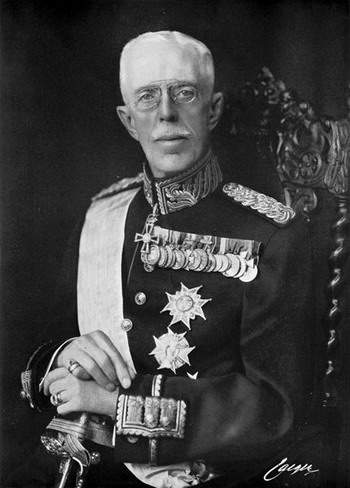
King Gustav V of Sweden
King Gustav V married Princess Victoria of Baden in 1881, and the marriage produced three children, all sons. The eldest son crown prince Gustav Adolph succeeded his father Gustav V, after his death on October 29, 1950. King Gustav VI Adolf married Princess Margaret of Connaught in 1905, and in 1907 when his father Gustav V ascended the Swedish throne, Gustav Adolf and Princess Margaret of Connaught became the Crown Prince and Princess of Sweden. In the year 1911, when the Crown Prince and Princess of Sweden attended the coronation in London of King George V and Queen Mary, Queen Sofia loaned her emerald and diamond parure to the Crown Princess Margaret to adorn herself for the occasion. At that time the collier was said to have seven pendants, whereas now there is only one.
Two years after this, in 1913, Queen Sofia died and bequeathed her emerald and diamond parure to her daughter-in-law by her third son, Princess Ingeborg, the wife of Prince Carl of Sweden, the Duke of Vastergotland. Princess Ingeborg used the emerald parure for formal occasions for many years.
The Emerald and Diamond Parure is transferred from the Swedish Royal Family to the Norwegian Royal Family in 1937
Prince Carl of Sweden and Norway who was born in 1861 was the third son of King Oscar II and Queen Sofia. He married Princess Ingeborg of Denmark in 1897, and had four children, three daughters and a son. Their third daughter Princess Astrid (1905-1935) later became the Queen of the Belgians.
Their second daughter Princess Martha (1901-1954) married her cousin HRH Crown Prince Olav of Norway on March 21, 1929, and Princess Martha, became the Crown Princess of Norway. The wedding of Crown Prince Olav of Norway to Princess Martha, was the first royal wedding in Norway in 340 years. The royal couple had three children, Princes Ragnhild born in 1930, Princess Astrid born in 1932, and Prince Harald born on February 21, 1937. The birth of Prince Harald in 1937, the long-awaited son who would be the future heir to the throne of Norway, was an occasion of great joy and happiness to Crown Prince Olav and Crown Princess Martha. The event was also a great source of happiness for Crown Princess Martha's parents, Prince Carl of Sweden and Princess Ingeborg, who gifted the historic emerald and diamond parure to their daughter, Princess Martha, to express their joy over the long-awaited birth. Thus the Empress Josephine de Beauharnais' emerald and diamond parure which was previously owned by members of the royal family of Sweden, was now transferred to the ownership of the royal family of Norway in 1937. Crown Princess Martha wore the emerald and diamond parure when she together with her husband, Crown Prince Olav, attended the coronations of King Geroge VI in 1937 and later Queen Elizabeth II in 1953.
Crown Princess Martha of Norway
Crown Prince Olav and Crown Princess Martha toured the United States in 1939, just before the outbreak of World War II in Europe, and during this trip struck a close relationship with President Franklin Roosevelt and the first lady Eleanor Roosevelt. In 1940, when German troops invaded Norway, Princess Martha and the three children fled to her native Sweden where she was not so welcome, the Government of Sweden taking the view that her presence might compromise the neutrality of Sweden. President Roosevelt hearing of her plight invited her and her family to the United States, and she sailed for the U.S. on the USS American Legion, embarking from the port city Petsamo in Finland. During her stay in the United States throughout the period of the war, her friendship with the Roosevelts were strengthened further. While in the United States she worked for the Red Cross and also took care of Norwegian interests, working tirelessly to get the support of the American people and the government to Norway's cause. Eventually when Princess Martha returned to Norway after the war, she was given a hero's welcome, and referred to as the "Mother of the Nation."
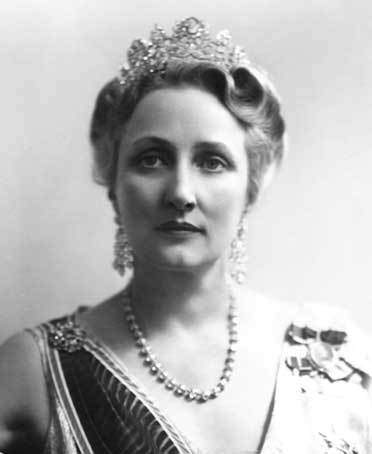
Crown Princess Martha of Norway
©Royal family of Norway
After the war she continued to serve Norway in different ways in her capacity as the Crown Princess and the "Mother of the Nation" and also assisted her husband the Crown Prince Olav in his day to day activities. However in the early 1950s her health began to fail, and she suffered from serious sickness diagnosed to be caused by cancer, which resulted in her death in 1954, three years before her husband ascended the throne. Even though Crown Princess Martha did not survive to become the Queen of Norway, she achieved for Norway during her tenure as Crown Princess, more than what a queen could have achieved in a life time. Crown Princes Martha left the emerald and diamond parure to the future Crown Prince after her death.
King Olav V of Norway
Olav V, was born in Norfolk, United Kingdom, on July 2, 1903, to Prince Carl of Denmark and Princess Maud, the daughter of King Edward VII of the United Kingdom. In 1905, when his father Prince Carl was offered the throne of the newly independent Norway, and became King Haakon VII of Norway, Olav V, became the crown prince of Norway. Olav graduated from the Norwegian Military Academy in 1924, and later studied jurisprudence and economics at Balliol College, Oxford.

King Olav V- The People's King
During the period of the war Crown Prince Olav stayed behind in Norway initially and later moved to the United Kingdom with the royal family when the government decided to go into exile. His extensive military training as crown prince helped him to take on a valuable role as adviser both to the civilian and military leaders. During the period of the war he made several trips to the Norwegian and Allied troops stationed in United Kingdom, Canada and the United States. His contribution to the war received international recognition and was awarded several medals and decorations by different nations, such as Norway, France, Greece, the Netherlands and the United States.
In the year 1957, upon the death of his father Haakon VII, he ascended the throne of Norway as King Olav V. His wife Crown Princess Martha had died just 3 years before of complications caused by cancer. King Olav V became one of the most popular rulers Norway had ever had in its history. He was known as the "People's King", as he moved freely with the people, driving his own cars, and sometimes traveling by public transport. He was loved and respected by his people, for he never kept aloof from them and was approachable by even the humblest of subjects if a need arose. Little wonder then that when he died in 1991, there was a spontaneous outpouring of grief by the people of Norway of all walks of life, unprecedented in the history of the country. The people lit hundreds of thousands of candles in the courtyard outside the Royal Castle in Oslo, and placed letters of condolence and cards amongst them, a final tribute to their beloved king. Indeed, King Olav V during his reign as King of Norway had set a worthy precedence to all future monarchs and other political leaders around the world, by making his exalted office meaningful to the common people of the nation, and not an abstract concept.
Harold V of Norway
Crown Prince Harald ascended the throne of Norway on January 17, 1991, after the death of his father King Olav V, the "People's King." He was the youngest of the three children of King Olav V and Crown Princess Martha, the two other elder children being daughters. Born on February 21, 1937, he was the first crown prince to be born in Norway since 1370. Harold V is a great grandson of King Edward VII of the United Kingdom, and is a second cousin to Queen Elizabeth II.
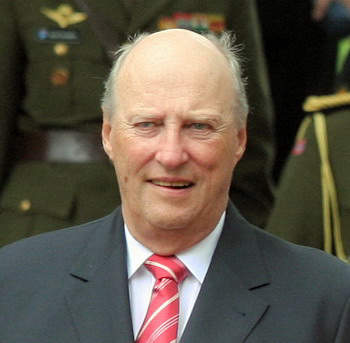
King Harald V ,present king of Norway
In 1940, when Hitler's troops invaded Norway, Harald V was just three years old. Crown Princess Martha and her three children escaped to Sweden and later, on an invitation by President Roosevelt of the U.S. left for the U.S. on board an American ship from Finland. During the period of the war Harold V grew up in the United States. While in the U.S. he started his primary education at the White Hall Country School in 1943, and accompanied his mother when she visited Norwegian serviceman on training in the U.S. and Canada. At the end of the war in 1945, the family returned to Norway to a hero's welcome. In the autumn of that same year Crown Prince Olav enrolled his son Harold in the 3rd grade of Smestad Skole, the first child from a royal family to attend a public school in Norway. This clearly demonstrated the Crown Prince's early inclination towards a people-friendly monarchy. After graduating from secondary school in 1955, he joined the Norwegian Military Academy from which he graduated in 1959. In 1960, he entered Balliol College, Oxford, where he studied history, economics and politics. While at oxford he took a keen interest in rowing, a favorite pastime that eventually led him to represent Norway in the rowing events in the Olympic games on several occasions. In the 1964 Summer Olympics held in Tokyo, Crown Prince Harald, led the Norwegian national team, carrying its flag at the opening parade. In the World Championship sailing competitions his crew had on bronze, silver and gold medal on different occasions. In the European Championships held in the year 2005, he and his crew aboard the royal sail boat won the gold medal, and as recently as year 2007 his team was placed 6th in the World Championships. King Harald participated in the Championships of 2005 and 2007, after recovering from two surgical operations for urinary bladder cancer and aortic valve replacement to correct aortic stenosis, performed respectively in December 2003 and April 2005.
Crown Prince Harald had served as deputy to King Olav V from the age of 18 years, attending Council of State meetings and acting as regent in the absence of the King. In the year 1968, Crown Prince Harald married Sonja Haraldsen a commoner, with whom he had been in love for nine years. The proposed marriage sparked off much public controversy, but appears to have received the blessings of King Olav V, the "People's King" and the approval of the Parliament. They were blessed with two children, a daughter Princess Martha Lewis and a son HRH Crown Prince Haakon, heir to the Norwegian throne.
Queen Sonja of Norway
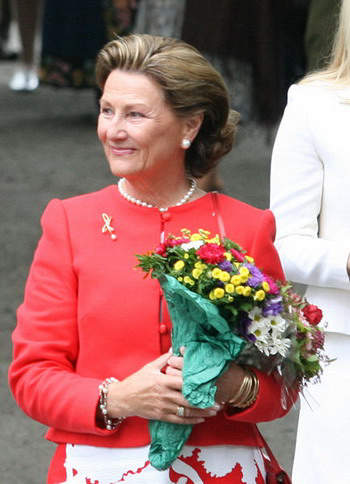
Queen Sonja of Norway
Queen Sonja is the Queen Consort of Norway and the wife of King Harald V of Norway. She is a commoner, the daughter of Karl August Haraldsen, and his wife nee Dagny Ulrichsen, and was born on July 4, 1937. Thus she is only five months younger to her husband King Harald. Crown Prince Harald and Miss Sonja had been secretly dating for nine years, and eventually when she wanted to marry her in 1968, it sparked off a public controversy due to her non-royal status. King Olav V being a "Peoples King" would have undoubtedly agreed to the marriage, but he had to get the approval of parliament before consenting to the marriage. The parliament did give its approval, and the marriage took place on August 29, 1968. After the marriage, Miss Sonja was given the title of Her Royal Highness and the Crown Princess of Norway. When Crown Prince Harold ascended the throne on January 17, 1991, Sonja became the Queen Consort of Norway. The royal couple has two children and four grand-children.
The Norwegian Emerald and Diamond Parure given to Queen Sonja by King Harald V
The emerald and diamond parure left by Crown Princess Martha at the time of her death in 1954, to Crown Prince Harald, was given to Queen Sonja after her marriage to the Crown Prince. Queen Sonja has often been seen wearing the emerald and diamond parure at formal occasions.
The Norwegian Emerald and Diamond Parure was never a crown jewel ? Queen Sonja of Norway is the 9th owner of the parure.
The Norwegian Emerald and Diamond Parure, since the time of its creation by the master craftsmen of Paris, for Napoleon Bonaparte's Queen Consort Empress Josephine, had been the personal property of members of royalty, and never a crown jewel. It belonged to Empress Josephine's personal jewelry collection and was bequeathed to her son Eugene de Beauharnais who gave it to his wife Princess Augusta Amelia. The parure which has a history of over 200 years had been bequeathed from one member of royalty to another, but had always remained the personal property of a member of the royalty. This explains why the parure moved from one country to another, starting from France, then to Italy, Brazil, Portugal, Sweden, and finally ending up in Norway. The number of years the parure had been in different countries are as follows :- France-10 years, Italy/Bavaria-15 years, Brazil-2 years, Portugal-39 years, Sweden-64 years, and Norway-71 years. The present Queen Sonja of Norway is the 9th owner of the celebrated parure. Please see table below.
The course of the Empress Josephine Emerald and Diamond Parure from France to Norway
| S/N |
Owner |
Country | Period |
Number of Years |
| 1 | Empress Josephine | France | 1804-1814 | 10 |
| 2 | Eugene de Beauharnais/ Augusta Amelia | Italy/Bavaria | 1814- 1829 | 15 |
| 3 | Princess/Empress Amelie | Brazil | 1829-1831 | 2 |
| 4 | Empress Amelie | Europe ? | 1831-1834 | 3 |
| 5 | Empress Amelie | Portugal | 1834-1873 | 39 |
| 6 | Queen Josephine | Sweden | 1873-1876 | 3 |
| 7 | Queen Sofia of Nassau | Sweden | 1876-1913 | 37 |
| 8 | Princess Ingeborg | Sweden | 1913-1937 | 24 |
| 9 | Princess Martha | Norway | 1937-1954 | 17 |
| 10 | Crown Prince Harald | Norway | 1954-1968 | 14 |
| 11 | Crown Princess/Queen Sonja | Norway | 1968- 2008 | 40 |
| Total | 204 |
You are welcome to discuss this post/related topics with Dr Shihaan and other experts from around the world in our FORUMS (forums.internetstones.com)
Related :-
Cambridge and Delhi Dunbar Parure
Emerald and Diamond Parure of Marie Louise Empress of France
Grand Duchess of Vladimir Tiara
Tiaras of the Iranian Crown Jewels
References
1.Josephine - Napoleon's Incomparable Empress, Eleanor P. Delorme
2.Tiara - Diana Scarisbrick (2000)
3.Timeless Tiaras- Dians Scarisbrick (2003)
4.Amelie of Leuchtenberg -From Wikipedia, the free encyclopedia
5.Josephine of Leuchtenberg - From Wikipedia, the free encyclopedia
6.Oscar I of Sweden - From Wikipedia the free encylopedia
7.Sofia of Nassau - From Wikipedia the free encyclopedia
8.Gustav V of Sweden - From Wikipedia the free encyclopedia
9.Princess Martha of Sweden - From Wikipedia, the free encyclopedia
10.Harald V of Norway- From Wikipedia, the free encyclopedia
Powered by Ultra Secure
Amazon (USA) Cloud Network

Founder Internet Stones.COM
Register in our Forums
| Featured In
|
|
|
|
|
|
|
|


















